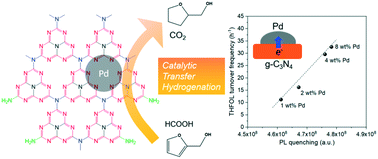Palladium nanoparticles supported on nanosheet-like graphitic carbon nitride for catalytic transfer hydrogenation reaction†
Abstract
In this study, palladium nanoparticles supported on bulk and nanosheet-like graphitic carbon nitride (Pd/b-CN and Pd/ns-CN) were prepared and studied for the catalytic transfer hydrogenation (CTH) of furfuryl alcohol (FOL) into tetrahydrofurfuryl alcohol (THFOL) with formic acid (HCOOH) as a hydrogen donor. Sorption experiments show that Pd/ns-CN possesses a higher specific surface area, more surface basic sites, and a higher Pd dispersion as compared to Pd/b-CN. Electronic and optical characterizations suggest that Pd nanoparticles are primarily deposited on the surface sites associated with pyridinic nitrogen atoms, forming an interfacial Mott–Schottky heterojunction that enables electron transfer from the CN support to the Pd nanoparticles. Catalytic testing indicates that as compared to Pd/b-CN, Pd/ns-CN displays a higher turnover frequency (TOF) for THFOL production. According to the experimental observations, we have proposed a catalysis mechanism, in which surface basic sites in abundance and Pd nanoparticles enriched with electrons are believed to be crucial to activate HCOOH (through the cleavages of O–H and C–H bonds) to transfer hydrogen to the C![[double bond, length as m-dash]](https://www.rsc.org/images/entities/char_e001.gif) C bonds in the furan ring of FOL to yield THFOL.
C bonds in the furan ring of FOL to yield THFOL.



 Please wait while we load your content...
Please wait while we load your content...